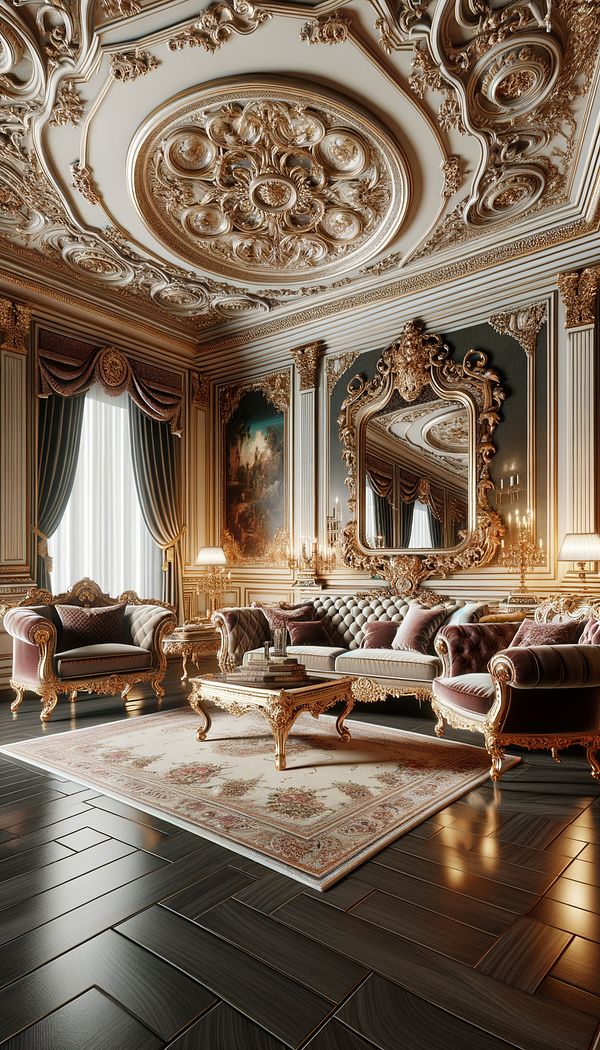What is Baroque?
Baroque is a highly decorative and theatrical style of architecture, art, and design that originated in the early 17th century in Europe.
Description
The Baroque period, spanning from the early 17th to the mid-18th century, marks a significant era in the history of European architecture, art, and interior design. Distinguished by its exuberance, grandeur, and attention to detail, the Baroque style aimed to evoke emotion and astonishment. This was achieved through the use of bold ornamentation, dramatic contrasts of light and shadow, and the integration of the arts to create a cohesive sensory experience.
In interior design, Baroque is synonymous with opulence and luxury. Interiors are characterized by rich colors, lavish textiles such as velvet and silk, and an abundance of ornate decorations including sculptures, gilded furniture, and oversized paintings. Ceilings and walls may be adorned with elaborate frescoes and plasterwork that showcase scenes of mythology or religious subjects.
The intention behind the Baroque style was not merely to display wealth and power but also to captivate and move the viewer. Architects and designers of the time skillfully manipulated spaces using dynamic shapes and perspective illusions to create an immersive environment. Key elements of Baroque design include complex, curvilinear forms, a strong emphasis on verticality and light, and an intricate juxtaposition between the ornate and the theatrical.
Usage
Baroque style can be found in historic palaces, churches, and grand residences across Europe, such as the Palace of Versailles in France and St. Peter’s Basilica in Vatican City. In modern interior design, elements of Baroque can be incorporated through decorative pieces, furniture types, and textiles and upholstery, adding a touch of luxury and historical depth to spaces.
FAQs
-
How does Baroque differ from Rococo?
Baroque and Rococo are both decorative styles that emerged in Europe, but they differ in their visual approach and historical context. Baroque is more opulent and grandiose, with a strong emphasis on drama and contrast, while Rococo is lighter, featuring more delicate and playful designs. Rococo, which developed later, is often considered a more refined and intimate iteration of the Baroque style, with a greater focus on asymmetry and pastel colors.
-
Can Baroque elements be integrated into contemporary interior design?
Yes, integrating Baroque elements into contemporary interior design can add a layer of richness and history. This can be achieved through the inclusion of ornate furniture pieces, luxurious fabrics, and decorative accents that pay homage to the Baroque aesthetic. However, balance is key to ensure the space does not feel overly opulent or disconnected from its modern context.
-
What are key decorative elements of Baroque interior design?
Key decorative elements of Baroque interior design include elaborate frescoes and plasterwork, gilded furniture, sculptural decorations, rich textiles like velvet and silk, and large-scale artworks. These elements work together to create a lavish and visually captivating environment.
-
Is Baroque style suitable for small spaces?
While Baroque style is characterized by its grandeur and lavishness, careful selection of Baroque-inspired decorative elements can enhance smaller spaces without overwhelming them. Choosing specific pieces, such as a gilded mirror or a luxurious velvet accent chair, can introduce Baroque elegance without requiring a large, palatial setting.
Practical Application
To incorporate the Baroque style into a space, focus on selecting opulent materials, elaborate decorative objects, and furniture pieces that reflect the period's distinctive features. Use rich, deep color palettes and incorporate dramatic lighting to highlight the luxurious elements. Be mindful of the balance between historical accuracy and contemporary functionality to ensure the space remains livable and inviting.
-
Architectural Elements199 articles
-
Design Styles478 articles
-
Materials & Textiles360 articles
-
Furniture Types599 articles
-
Decorative Techniques322 articles
-
AmericanaAmericana refers to artifacts, or a collection of artifacts, related to the history, geography, folklore, and cultural heritage of the United States.
-
AppliquéAppliqué is a decorative design technique involving the attachment of cutout pieces of material onto a larger piece to create patterns or designs.
-
Campaign FurnitureCampaign furniture is portable, foldable furniture designed for travel and military campaigns.
-
RusticRustic refers to a design style that embraces natural, rugged, and aged elements to create an authentic and earthy feel.
-
DownDown refers to the soft layers of fine feathers found beneath the tougher exterior feathers of birds, often used for insulation and padding in a variety of interior design elements.
